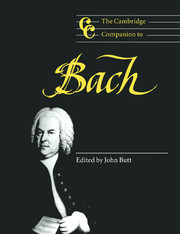Book contents
- Frontmatter
- Introduction
- Part I The historical context: society, beliefs and world-view
- Part II Profiles of the music
- 6 The early works and the heritage of the seventeenth century
- 7 The mature vocal works and their theological and liturgical context
- 8 The instrumental music
- 9 The keyboard works: Bach as teacher and virtuoso
- 10 Composition as arrangement and adaptation
- 11 Bachian invention and its mechanisms
- Part III Influence and reception
- Notes
- Select bibliography
- General Index
- Index of works
8 - The instrumental music
from Part II - Profiles of the music
Published online by Cambridge University Press: 28 September 2011
- Frontmatter
- Introduction
- Part I The historical context: society, beliefs and world-view
- Part II Profiles of the music
- 6 The early works and the heritage of the seventeenth century
- 7 The mature vocal works and their theological and liturgical context
- 8 The instrumental music
- 9 The keyboard works: Bach as teacher and virtuoso
- 10 Composition as arrangement and adaptation
- 11 Bachian invention and its mechanisms
- Part III Influence and reception
- Notes
- Select bibliography
- General Index
- Index of works
Summary
The repertory
The Bach literature shows no unified approach to the categorisation of the instrumental music: while some writers describe the entire repertory as ‘chamber music’, others speak of ‘chamber and orchestral music’. The reason for this uncertainty lies in the historical change in the meaning of the terms ‘chamber music’ and ‘orchestra’. For Bach's contemporaries, the term ‘chamber music’ covered all types of music written for the court and for domestic consumption, but excluded music intended for the church and theatre. In his letter releasing Bach from his service in 1723, the composer's employer in Köthen could write, therefore, that Bach had served him as ‘Kapellmeister and director of our chamber music’. According to our contemporary understanding of the term, it is now restricted to ‘music written for and performed by a small ensemble, usually instrumental, with one performer on a part’.
The word ‘orchestra’ was occasionally used in Bach's day to refer to a relatively large body of players, or so it would appear to be used by Silvius Leopold Weiss in a letter to Johann Mattheson of 1723: ‘But to accompany on the lute in the orchestra, that would of course be too weak.’ In general, however, it may be said that neither Bach nor his contemporaries drew a distinction in principie between an ‘orchestra’ and an ensemble that performed ‘chamber music’.
- Type
- Chapter
- Information
- The Cambridge Companion to Bach , pp. 123 - 135Publisher: Cambridge University PressPrint publication year: 1997



